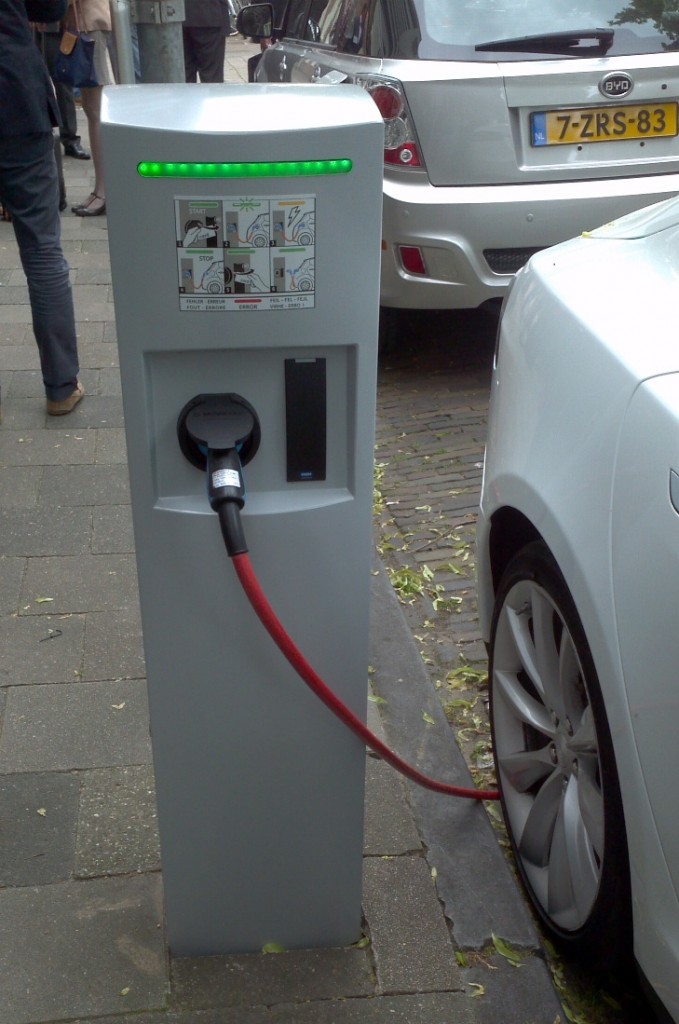Earlier this week I attended a vehicle-to-grid workshop organised by Nissan Europe. This one was held in Utrecht in The Netherlands, where I discovered that the workshop coincided with the announcement of a new partnership between the City of Utrecht and a number of Dutch companies to ultimately deliver 120 “smart charging stations” across Utrecht. There’ll be more from me on the workshop itself in due course, but for now let’s take a close look at the world’s first publicly available solar powered V2G capable AC electric vehicle charging station:
 The charging station itself is a GE DuraStation with added bi-directional capability. Sadly my wish of a few weeks ago has not yet come true, and the Tesla model S you can see in the foreground is still only capable of being charged by the DuraStation, which is IEC 61851/62196 mode 3 compliant. However the BYD e6 visible in the background IS able to discharge its batteries back to the local distribution grid.
The charging station itself is a GE DuraStation with added bi-directional capability. Sadly my wish of a few weeks ago has not yet come true, and the Tesla model S you can see in the foreground is still only capable of being charged by the DuraStation, which is IEC 61851/62196 mode 3 compliant. However the BYD e6 visible in the background IS able to discharge its batteries back to the local distribution grid.
This particular charger is situated outside the offices of LomboXnet, and hence integrated with the CHAdeMO compliant V2G system we reported on back in March, which stores the excess energy generated by the Solar PV installation at a nearby primary school. Here’s another angle on the event, showing Councillor Lot van Hooijdonk shortly after she cut the ribbon to officially open the charging station:
 Another part of my wish from last month has also yet to come true. In Utrecht as in the United Kingdom, and despite the red carpet, whether you own an electric vehicle manufactured by Nissan, BYD or Tesla, and whether it prefers to be charged via CHAdeMO, IEC 62196 or a Supercharger, you still won’t get paid for allowing your battery pack to be used to provide an extremely useful service to the local distribution grid. However, perhaps mighty oaks from little acorns do eventually grow?
Another part of my wish from last month has also yet to come true. In Utrecht as in the United Kingdom, and despite the red carpet, whether you own an electric vehicle manufactured by Nissan, BYD or Tesla, and whether it prefers to be charged via CHAdeMO, IEC 62196 or a Supercharger, you still won’t get paid for allowing your battery pack to be used to provide an extremely useful service to the local distribution grid. However, perhaps mighty oaks from little acorns do eventually grow?
Whilst we wait to discover if/when/how that happens, here’s the video that Robin Berg of LomboXnet showed the attendees of the 3rd Nissan V2G workshop:

What about the idea of standardizing batteries, so that they can be exchanged? That would save time waiting for one’s own individual battery to recharge.
Better Place didn’t work out too well though, and Tesla seem to be going off the idea also?
http://fortune.com/2015/06/10/teslas-battery-swap-is-dead/
Battery swap is one of those ideas that seems like a no-brainer, conceptually until you dig into the details.
What do people want? That it is simple. Not just that is quick. That it is simple. And reliable.
So a worst case.
A battery swap station next to a busy highway in a busy northern hemisphere city in winter. Snow, ice, rain, slush, mud, grit, salt, lots of traffic, high turn-over. Endless streams of dirty, wet, gritty, salty cars of multiple designs from multiple manufacturers pull in and need their battery pack swapped.
Hopefully automated equipment that can extract the battery packs from wherever they are located in the vehicle – depending on how well standardization of access methods has been standardized.
And can then do this vehicle after dripping filthy vehicle without any issues of fouling and contamination of:
– access mechanisms,
– alignment/detection mechanisms,
– electrical contact surfaces,
– vehicle/battery swap station communication systems,
– below ground battery transfer systems,
– battery type selection systems
– battery to charge point routing systems etc
– Maybe in dry/dusty environments/countries dust/salt infiltration of EVERYTHING..
– etc….
Battery swap sounds conceptually simple because it fits our paradigm. But the nuts and bolts of fitting it into our messy real world physical environment is truly daunting.
In contrast our current system of fueling petroleum based cars only needs us to keep a very tiny part of the car clean – the few square cm’s around the filler cap.
Similarly, recharge systems only need a few square cm’s kept clean around the connector.
Neil Young said ‘Rust Never Sleeps’. Neither does water, grit, salt, dirt etc.
Pingback: A Renault 5 E-Tech Fleet Powers Utrecht With V2G |Vehicle to Grid UK